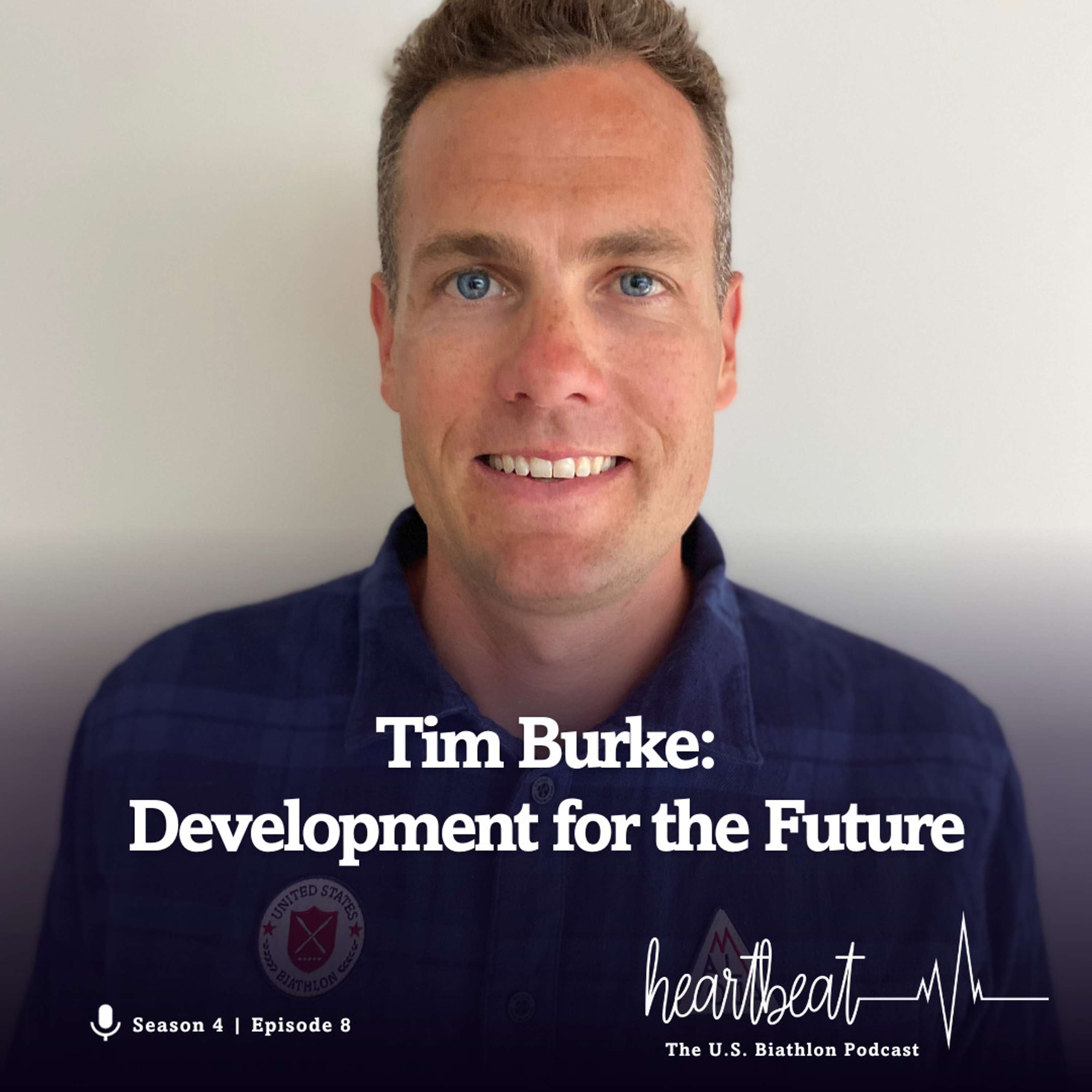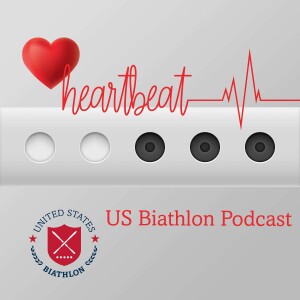
If the recent U.S. Biathlon Trials event at Mt. Itasca Winter Sports Center is any indicator, athlete development is on the upswing. Record numbers of athletes were on hand seeking to qualify for major youth and junior events. In this episode of Heartbeat, U.S. Biathlon’s Director of Athlete Development Tim Burke, talks about sustained competitive excellence as the objective of U.S. Biathlon’s strategic plan and the progress that’s being made.
Burke, a longtime athlete who won silver at the World Championships in 2013, is part of a strong athletic program at U.S. Biathlon. He works alongside Director of Sport Development John Farra and a longtime biathlete now managing high-performance, Lowell Bailey. The three all have roots growing up in Lake Placid and competing at the highest level. Now Burke is finding gratification in helping nurture the next generation to success.
At Mt. Itasca in late December, 80 athletes showed up to race – a bump of 45% from previous years. Notably, too, the field included a record 31 women - a big focus for U.S. Biathlon.
The trials offered athletes an opportunity to vie for spots on a wide range of international teams, most notably the Youth Olympic Games in South Korea and the IBU’s Youth and Junior World Championships in Estonia.
This episode of Heartbeat takes you into the heart of athlete development, representing the next generation of biathletes who will represent Team USA in the coming years.
Tim, how do you describe your role with U.S. Biathlon?
My title is the director of athlete development. However, we're a very small organization, so titles are one thing, but all of us do a little bit of everything. I work very closely with Lowell in high performance and with John Farra in sport development. But my main role is kind of working in the middle of the U.S. Biathlon pipeline – really focusing on those athletes in the middle of our pipeline who are coming up, ensuring that they have the opportunities and what they need to succeed in this part of their career so they can make a smooth transition into the senior circuit.
How does your role fit into U.S. Biathlon’s strategic plan?
Our plan of sustained competitive excellence. So what does that mean? That means taking us from an organization that has occasionally had some success for sure, that we're all very proud of, but we want to have that more consistently. And to have that more consistently, we need to be more professional. We need more athletes in our pipeline, and ultimately, we need to be able to field teams on the World Cup, at World Championships, at the Olympics, where we can field a full team of athletes who are capable of stepping onto that podium. If we can do that, we will finally win that elusive Olympic medal. But it all starts at the bottom. It all starts with grassroots. It all starts at our clubs. It all starts down there building those numbers so that we have the athletes, enough athletes coming through our pipeline that can rise to the top.
What differences do you see in athlete development today versus a few years ago?
One of the biggest differences right now, as compared to when I came through the pipeline, is we're seeing a lot more of these crossover nordic athletes transitioning into biathlon. And it's not only true for our country, but it's true for others as well. You've seen other countries have a lot of success, like Sweden, like Germany, like Slovenia right now. And we want to be a part of that, and we have been a part of that. If you look at our national team right now, if you look at the World Cup that just happened this morning, many of those athletes racing for us, racing in that US uniform, are athletes that came over from cross country at a pretty late age. A lot of them came after they finished college. You know, they were successful collegiate skiers and they wanted to try something different. And we tried to provide those opportunities for them in biathlon. And that's one thing that we are continuing to really focus on and even double down on. Here at U.S. Biathlon is making sure that we have a really [00:06:00] well-developed pathway for these talented nordic skiers who want to give biathlon a chance.
How important are venues like Mt. Itasca?
Mt. Itasca is definitely an important venue for us. They've hosted a lot of trials events for us in the past, and we've also seen a ton of athletes from Mt. Itasca, from the Minnesota area, come on to our national teams and Olympic teams in the past. I certainly think that's something we're going to continue to see in the future.
You qualified a team of three men, three women to Youth Olympic Games. What do you want to see for them in South Korea?
My goal for those athletes, the biggest takeaway I want them to have from there, is I want them to leave there just incredibly motivated to continue pursuing biathlon at a high level. I'm sure they will have that experience in Korea. You know, to be there at an event that's not only drawing the best athletes your age in the world for your sport, but to be there at an event where you have athletes from all different disciplines from all over the world is incredibly, incredibly motivating for these athletes. I'm super excited for them to have this experience.
Do you remember your first international trip?
Absolutely! I remember my first international trip was to Torsby, Sweden. It was a Scandinavian Cup at the time. I remember being incredibly nervous. But again, getting over there, having a having an amazing time, and coming back motivated and really hungry for more.
You had a record women’s field at Mt. Itasca, which has been an organizational goal, right?
Expanding the number of women in sport is definitely a big goal of ours. At U.S. Biathlon, it was great to see a record number for us in Mount Itasca. We had 31 women competing, and really nice to see some fantastic up-and-coming athletes who I wasn't really familiar with before this trials event – to see them coming up through the system and doing really well. And again, back to the competitiveness of those races, that women's race for those last team spots, for all of the team spots, really, it was tight. It really came down to the last race, and it could have gone to a lot of different women. That was just really, really cool and inspiring for me and everyone at U.S. Biathlon to see.
What gives you the most satisfaction now as an athlete leader?
Oh, that's a great question and a really tough one. It depends on the day, os I think what my answer would be. But since this one is really fresh in mind, since we just finished up with team naming, I'll give you this. It was so fun to call those athletes who qualified for our teams and chat with them and let them know that their hard work paid off and that they would be headed out soon on an international trip. Hearing that excitement in their voices was really, really inspiring for me to hear. And those are the calls, you love to make.
More Episodes
 2024-10-10
2024-10-10
 2024-10-01
2024-10-01
 2024-03-06
2024-03-06
 2024-03-05
2024-03-05
 2024-02-06
2024-02-06
 2023-12-24
2023-12-24
 2023-11-21
2023-11-21
 2023-11-10
2023-11-10
 2023-11-06
2023-11-06
 2023-10-23
2023-10-23
 2023-06-21
2023-06-21
 2023-04-19
2023-04-19
 2023-03-19
2023-03-19
 2023-02-28
2023-02-28
 2023-02-08
2023-02-08
Create your
podcast in
minutes
- Full-featured podcast site
- Unlimited storage and bandwidth
- Comprehensive podcast stats
- Distribute to Apple Podcasts, Spotify, and more
- Make money with your podcast
It is Free
- Privacy Policy
- Cookie Policy
- Terms of Use
- Consent Preferences
- Copyright © 2015-2024 Podbean.com






